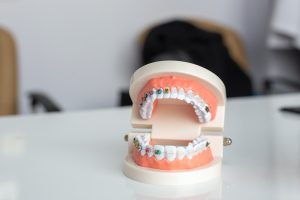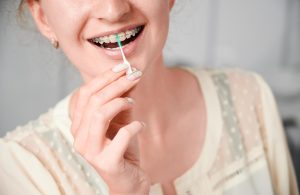Braces are a common and effective solution for improving both the health and appearance of your teeth. As highlighted in this braces guide, while they’re often associated with teenagers, people of all ages can benefit from orthodontic treatment. Whether you’re looking to correct bite issues or simply want a straighter smile, braces can play a significant role in transforming your dental health.
Orthodontic treatment with braces works by gradually shifting your teeth into their proper positions. Over time, this can improve the alignment of your teeth and jaw, leading to a healthier, more functional bite and an enhanced smile. But braces aren’t just for cosmetic reasons—straight teeth can prevent future dental problems, such as tooth decay, gum disease, and excessive wear on your teeth.
The Basics of Getting Braces

Before deciding whether braces are right for you, it’s important to understand the basics—why you might need them and when is the best time to get them. This braces guide will help you grasp the purpose of braces, which are designed to fix dental issues, enhance your smile, and ensure your teeth and jaw are aligned correctly. Here’s what you need to know:
Why Consider Braces?
Braces can do much more than just straighten your teeth. They are used to correct various dental problems, including:
- Bite issues: Braces can fix bite problems such as an overbite (when your upper teeth protrude too far over your lower teeth), underbite (when your lower teeth extend beyond your upper teeth), and crossbite (when some of your upper teeth sit inside your lower teeth). These problems can affect your ability to chew properly, speak clearly, and even smile with confidence.
- Crooked or crowded teeth: If your teeth overlap or are too close together, braces can create space to straighten them. This not only improves the appearance of your smile but also makes it easier to clean your teeth, preventing issues like cavities or gum disease.
- Teeth spacing: Some people have gaps between their teeth, which can be corrected using braces. Closing the gaps improves both the look of your smile and the functionality of your bite.
Rules for Getting Braces
Getting braces is an exciting step towards improving your smile, but before you embark on your orthodontic journey, it’s important to understand the rules and expectations involved. This section of the braces guide covers everything from your first consultation to the day your braces are put on, highlighting several key factors to consider.
Initial Consultation
The first step in getting braces is scheduling an initial consultation with an orthodontist. During this visit, the orthodontist will assess your teeth, gums, and jaw to determine if braces are right for you. Here’s what you can expect:
- Comprehensive Evaluation: The orthodontist will examine your teeth and bite. They may take X-rays, dental scans, and photos to get a detailed view of your oral structure.
- Discussion of Options: Based on the evaluation, your orthodontist will explain which type of braces may be best for you, as well as the potential treatment options and the length of time required.
- Setting Goals: You and your orthodontist will work together to set goals for your treatment, such as improving the alignment of your teeth, correcting bite problems, or closing gaps. This ensures that your treatment plan is tailored to your needs.
- Cost and Payment: The orthodontist will also discuss the cost of treatment, available payment plans, and what is covered by insurance. Understanding the financial aspect of braces early on helps you plan accordingly.
Planning Your Treatment
Once you’ve decided to move forward with braces, your orthodontist will create a detailed treatment plan tailored to your specific dental needs. This section of the braces guide will outline what you can expect from your treatment plan, including the following:
Length of Treatment
The duration of treatment can vary from 18 months to 3 years, depending on the complexity of the issues being addressed. Your orthodontist will estimate how long you’ll need to wear braces based on your unique case.
Types of Braces
There are different types of braces available, and your orthodontist will discuss which option is best for you. These include:
- Traditional Metal Braces: The most common and affordable option, consisting of metal brackets and wires that gradually move the teeth into place.
- Ceramic Braces: These work similarly to metal braces but are made of clear or tooth-colored materials, making them less noticeable.
- Lingual Braces: Placed on the inside of the teeth, these are a great choice for those seeking a more discreet treatment.
- Clear Aligners (e.g., Invisalign): A modern alternative to traditional braces, clear aligners are removable, nearly invisible, and customized to fit your teeth.
Each type of brace has its pros and cons, and this braces guide will help you weigh your options to choose the one that best aligns with your goals and lifestyle.
Costs and Insurance
The cost of braces can vary based on factors like the type of braces chosen, the complexity of your treatment, and your location. On average, braces can cost between $3,000 and $7,000 or more. Some factors that influence the cost include:
- Type of Braces: Metal braces are typically the most affordable, while clear aligners and ceramic braces are more expensive.
- Length of Treatment: The longer you wear braces, the higher the cost. Complex cases may require more adjustments, which can increase the price.
- Insurance Coverage: Many dental insurance plans cover part of the cost of braces, though coverage varies. Some plans may cover braces for children but not for adults, so it’s essential to check your plan to see what’s included.
Step-by-Step Braces Guide
Getting braces involves several important steps, from your initial consultation to the day your braces are put on, and the regular check-ups that follow. Here’s a simplified look at the process:
Step 1: Initial Assessment
The first visit to your orthodontist includes a comprehensive evaluation of your teeth, gums, and bite. Expect the orthodontist to take X-rays, impressions, and photographs to create a personalized treatment plan. They’ll discuss the best type of braces for you and outline the expected duration of treatment.
Step 2: Fitting the Braces
The day you get your braces, you’ll have your teeth cleaned and the brackets bonded to the surface of your teeth. A wire is then threaded through the brackets, applying gentle pressure to gradually shift your teeth. This process can take a couple of hours, and while it may be uncomfortable, the orthodontist will ensure you’re at ease.
Step 3: Regular Adjustments
Every 4 to 6 weeks, you’ll visit the orthodontist for adjustments. They’ll tighten the wire, change rubber bands or ties, and check your progress. While adjustments may cause some discomfort, it’s part of the process to keep your teeth moving toward the desired position.
Step 4: Retainers
Once your braces are removed, you’ll wear a retainer to keep your teeth in place. Retainers can be removable or fixed (bonded to the back of your teeth), and you’ll typically wear them full-time for the first few months, then just at night. This ensures your teeth don’t shift back.
Do’s and Don’ts When Wearing Braces
To ensure your braces work effectively and stay in good condition, follow these braces guide simple do’s and don’ts.
Do’s
- Brush and Floss Regularly: Clean your teeth thoroughly, using a soft toothbrush and floss threaders to get between brackets and wires.
- Eat Soft Foods: Opt for softer foods like pasta, yogurt, and cooked vegetables. Cut food into small pieces to avoid damaging your braces.
- Attend All Appointments: Regular check-ups are crucial for making adjustments and keeping your treatment on track.
Don’ts
- Avoid Hard, Sticky, or Crunchy Foods: Stay away from foods like nuts, caramel, and popcorn, which can break your braces.
- Don’t Skip Appointments: Missing visits can delay progress, so keep your scheduled check-ups.
- Don’t Touch Your Braces: Avoid poking or playing with your braces, as this can cause damage. Contact your orthodontist if something feels off.
What Age is Best for Getting Braces?
Braces are commonly associated with children and teenagers, but they are not limited to young people. The ideal age for braces depends on the development of your teeth and jaw, and treatment can be effective at various stages of life.
Children and Adolescents
The best time for braces is generally between the ages of 7 and 14. At this age, the jaw is still growing, which allows the orthodontist to guide the teeth into the correct position more easily. Early intervention can also help address any developing bite problems before they become more complicated. If necessary, some children may start with early treatments like expanders or spacers to prepare for braces later on.
Adults and Braces
It’s never too late to get braces. Many adults get braces to fix alignment issues that weren’t addressed when they were younger or because their teeth have shifted over time. While it may take longer for adults to achieve results, as their bones are no longer growing, braces can still work effectively. Adults can choose from various options like clear aligners (e.g., Invisalign) for a more discreet treatment, or traditional braces if preferred.
Tips for a Comfortable Braces Experience
Braces may cause some discomfort, but with a few simple tips, you can make your experience more comfortable and smooth.
1. Manage Discomfort
- Pain Relief: Use over-the-counter pain relievers like ibuprofen or acetaminophen to ease soreness after getting braces or adjustments.
- Soft Foods: Stick to soft foods, such as yogurt and mashed potatoes, to avoid irritation.
- Cold Compress: Apply a cold compress to reduce swelling and numb any discomfort.
2. Protect Your Mouth
- Orthodontic Wax: Use wax to cover brackets if they irritate the inside of your mouth.
- Mouthguards: If you play sports, wear a mouthguard to protect your braces and teeth.
3. Maintain Good Oral Care
- Clean Teeth Regularly: Use a soft-bristled toothbrush, floss threaders, and mouthwash to keep your braces clean and prevent plaque buildup.
4. Avoid Certain Foods
- Sticky or Hard Foods: Avoid gum, caramel, and hard candies that can damage your braces.
- Cut Food into Small Pieces: This helps reduce pressure on your braces and makes eating more comfortable.
Your Perfect Smile Starts Here—Get Started Now!
At Smiles Orthodontics, we’re dedicated to helping you achieve the smile you’ve always dreamed of! Led by expert orthodontists Dr. Bobby Virk and Dr. Helena Skountrianos, we offer personalized treatment plans tailored to your unique needs. Whether you’re interested in traditional braces, clear aligners like Invisalign, or other options, we provide flexible payment plans to ensure your journey is as smooth as possible.
Don’t wait to transform your smile! Contact us today to schedule a free consultation and take the first step toward a confident, healthier smile. Our team is here to support you every step of the way with advanced treatments, cutting-edge technology, and a commitment to exceptional care.


